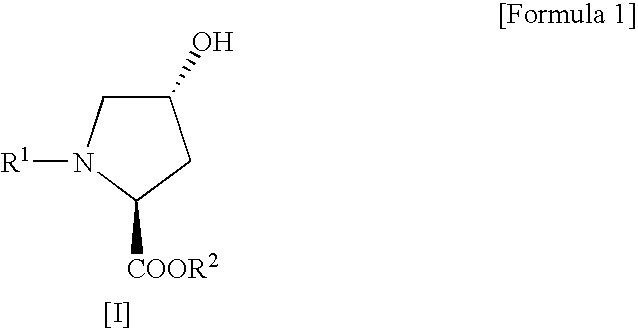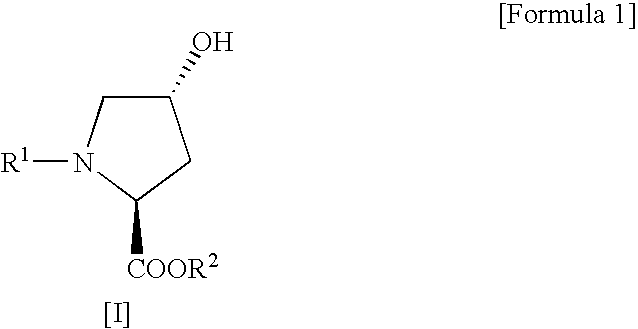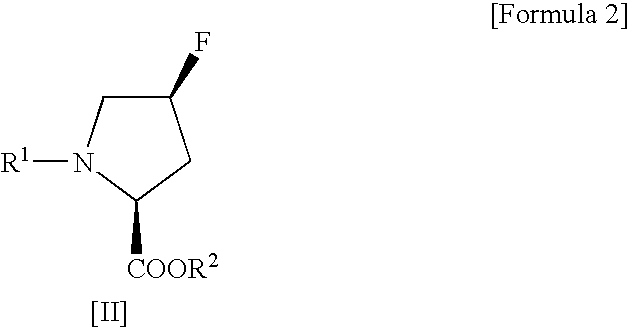Process for production of cis-4-fluoro-l-proline derivatives
a technology of cis-4fluoro-l-proline and production method, which is applied in the field of producing a cis-4fluoro-l-proline derivative, can solve the problems of unsuitable industrial use, limited practical use of methods, and unsuitable fluorination techniques, and achieves the effect of avoiding side reactions, enabling industrial production of a target compound, and high yield
- Summary
- Abstract
- Description
- Claims
- Application Information
AI Technical Summary
Benefits of technology
Problems solved by technology
Method used
Image
Examples
example 1
Synthesis of methyl(2S,4S)-1-(tert-butoxycarbonyl)-4-fluoropyrrolidine-2-carboxylate
[0028]
[0029] Methyl(2S,4R)-1-(tert-butoxycarbonyl)-4-hydroxypyrrolidine-2-carboxylate (4.91 g, 0.020 mol) and sodium fluoride (1.01 g, 0.024 mol) were suspended in dichloromethane (50 mL), followed by addition of Ishikawa reagent (4.35 mL, 0.024 mol) under ice cooling. The reaction mixture was slowly warmed to room temperature and then stirred for 20 hours. After the reaction, the reaction mixture was poured into ice-cold saturated aqueous sodium bicarbonate (70 mL) and then separated into organic and aqueous layers. The aqueous layer was extracted with ethyl acetate. This extracted solution was combined with the organic layer obtained above, washed sequentially with 10% aqueous potassium bisulfate and saturated aqueous sodium chloride, and then dried over anhydrous sodium sulfate. After drying, the solvent and the decomposition product of Ishikawa reagent (N,N-diethyl-2,3,3,3-tetrafluoropropionamid...
example 2
Synthesis of methyl(2S,4S)-1-benzyloxycarbonyl-4-fluoropyrrolidine-2-carboxylate
[0032]
[0033] Methyl(2S,4R)-1-benzyloxycarbonyl-4-hydroxypyrrolidine-2-carboxylate (306 mg, 0.00108 mol) and sodium fluoride (55 mg, 0.00131 mol) were suspended in dichloromethane (1.8 mL), followed by addition of Ishikawa reagent (293 mg, 0.00131 mol) under ice cooling. The reaction mixture was slowly warmed to room temperature and then stirred for 20 hours. After the reaction, the reaction mixture was poured into ice-cold saturated aqueous sodium bicarbonate (5 mL) and then separated into organic and aqueous layers. The aqueous layer was extracted with ethyl acetate. This extracted solution was combined with the organic layer obtained above, washed sequentially with 10% aqueous potassium bisulfate and saturated aqueous sodium chloride, and then dried over anhydrous sodium sulfate. After drying, the solvent and the decomposition product of Ishikawa reagent (N,N-diethyl-2,3,3,3-tetrafluoropropionamide) w...
PUM
| Property | Measurement | Unit |
|---|---|---|
| temperature | aaaaa | aaaaa |
| temperature | aaaaa | aaaaa |
| temperature | aaaaa | aaaaa |
Abstract
Description
Claims
Application Information
 Login to View More
Login to View More - R&D
- Intellectual Property
- Life Sciences
- Materials
- Tech Scout
- Unparalleled Data Quality
- Higher Quality Content
- 60% Fewer Hallucinations
Browse by: Latest US Patents, China's latest patents, Technical Efficacy Thesaurus, Application Domain, Technology Topic, Popular Technical Reports.
© 2025 PatSnap. All rights reserved.Legal|Privacy policy|Modern Slavery Act Transparency Statement|Sitemap|About US| Contact US: help@patsnap.com



